What Extent do Airline Loyalty Programs Contribute to Overall Passenger Satisfaction
VerifiedAdded on 2022/08/25
|16
|4636
|18
AI Summary
Contribute Materials
Your contribution can guide someone’s learning journey. Share your
documents today.
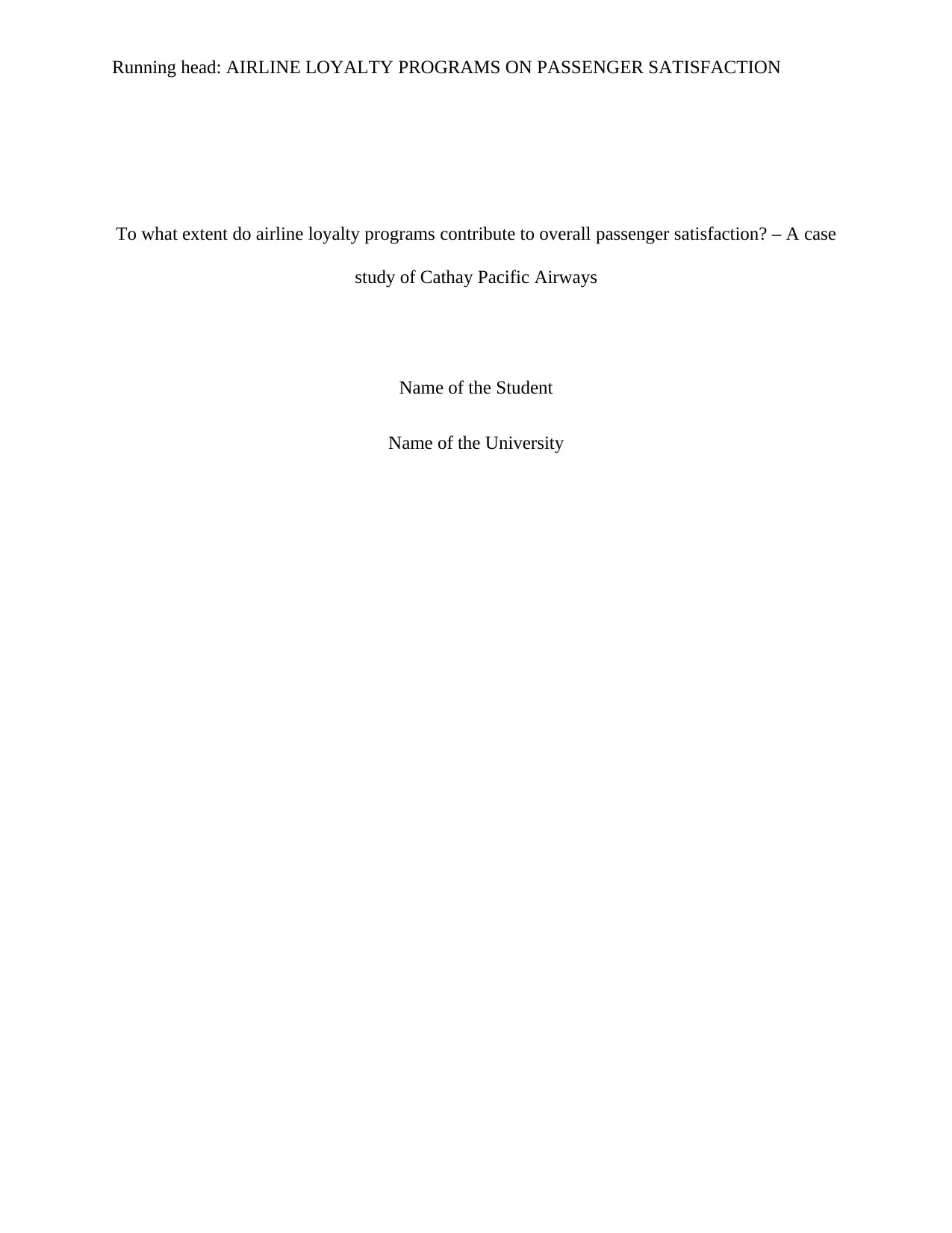
Running head: AIRLINE LOYALTY PROGRAMS ON PASSENGER SATISFACTION
To what extent do airline loyalty programs contribute to overall passenger satisfaction? – A case
study of Cathay Pacific Airways
Name of the Student
Name of the University
To what extent do airline loyalty programs contribute to overall passenger satisfaction? – A case
study of Cathay Pacific Airways
Name of the Student
Name of the University
Secure Best Marks with AI Grader
Need help grading? Try our AI Grader for instant feedback on your assignments.
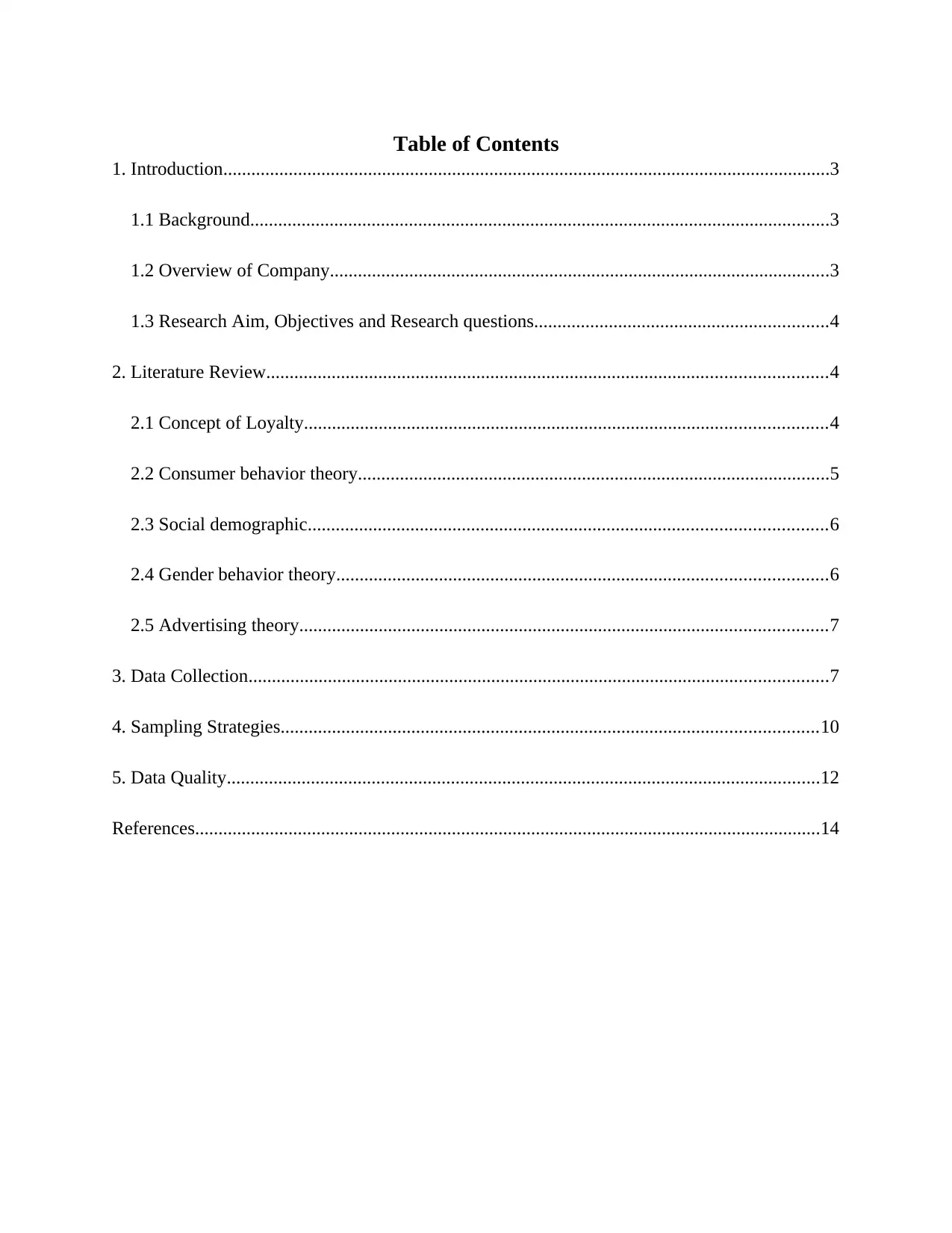
Table of Contents
1. Introduction..................................................................................................................................3
1.1 Background............................................................................................................................3
1.2 Overview of Company...........................................................................................................3
1.3 Research Aim, Objectives and Research questions...............................................................4
2. Literature Review........................................................................................................................4
2.1 Concept of Loyalty................................................................................................................4
2.2 Consumer behavior theory.....................................................................................................5
2.3 Social demographic...............................................................................................................6
2.4 Gender behavior theory.........................................................................................................6
2.5 Advertising theory.................................................................................................................7
3. Data Collection............................................................................................................................7
4. Sampling Strategies...................................................................................................................10
5. Data Quality...............................................................................................................................12
References......................................................................................................................................14
1. Introduction..................................................................................................................................3
1.1 Background............................................................................................................................3
1.2 Overview of Company...........................................................................................................3
1.3 Research Aim, Objectives and Research questions...............................................................4
2. Literature Review........................................................................................................................4
2.1 Concept of Loyalty................................................................................................................4
2.2 Consumer behavior theory.....................................................................................................5
2.3 Social demographic...............................................................................................................6
2.4 Gender behavior theory.........................................................................................................6
2.5 Advertising theory.................................................................................................................7
3. Data Collection............................................................................................................................7
4. Sampling Strategies...................................................................................................................10
5. Data Quality...............................................................................................................................12
References......................................................................................................................................14
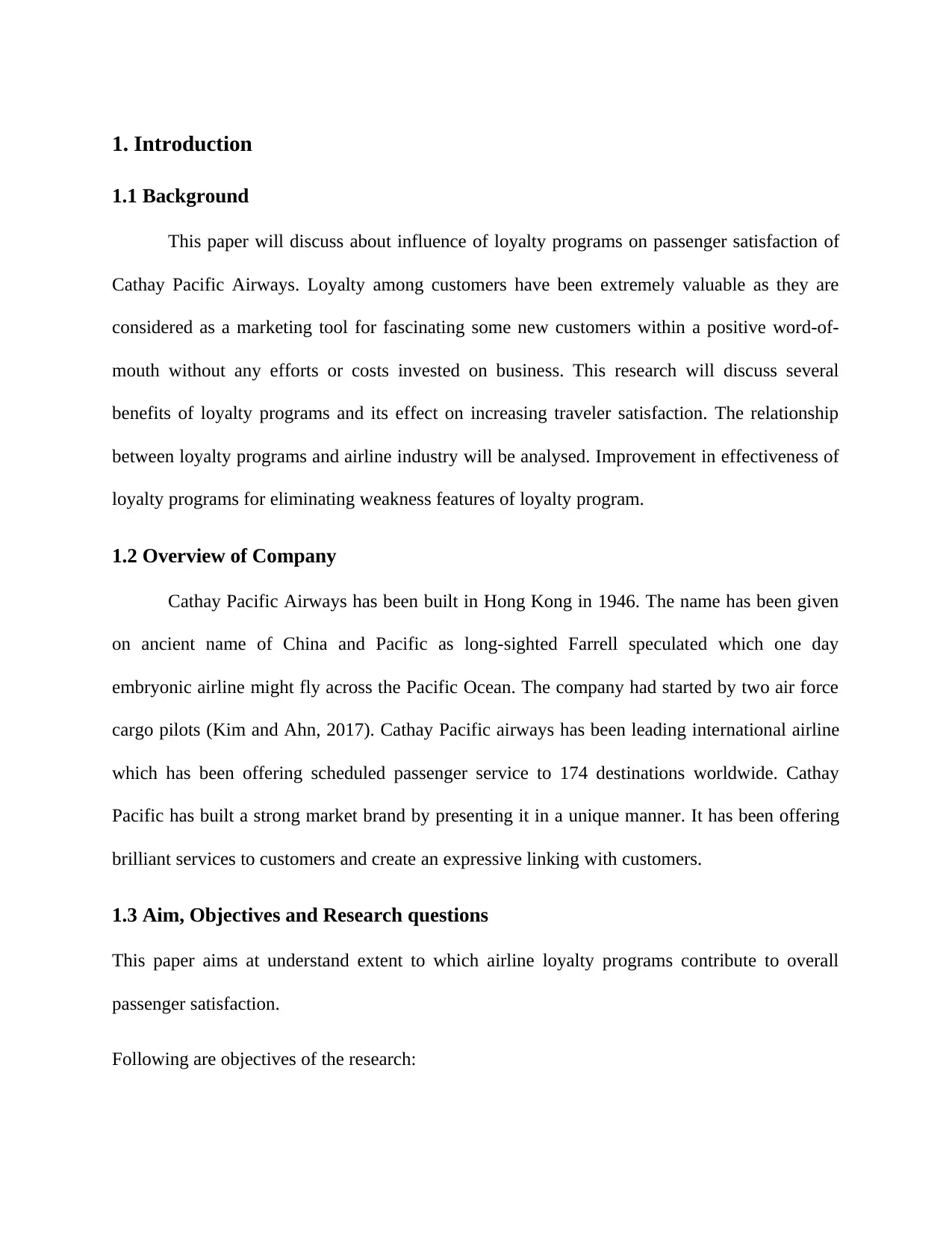
1. Introduction
1.1 Background
This paper will discuss about influence of loyalty programs on passenger satisfaction of
Cathay Pacific Airways. Loyalty among customers have been extremely valuable as they are
considered as a marketing tool for fascinating some new customers within a positive word-of-
mouth without any efforts or costs invested on business. This research will discuss several
benefits of loyalty programs and its effect on increasing traveler satisfaction. The relationship
between loyalty programs and airline industry will be analysed. Improvement in effectiveness of
loyalty programs for eliminating weakness features of loyalty program.
1.2 Overview of Company
Cathay Pacific Airways has been built in Hong Kong in 1946. The name has been given
on ancient name of China and Pacific as long-sighted Farrell speculated which one day
embryonic airline might fly across the Pacific Ocean. The company had started by two air force
cargo pilots (Kim and Ahn, 2017). Cathay Pacific airways has been leading international airline
which has been offering scheduled passenger service to 174 destinations worldwide. Cathay
Pacific has built a strong market brand by presenting it in a unique manner. It has been offering
brilliant services to customers and create an expressive linking with customers.
1.3 Aim, Objectives and Research questions
This paper aims at understand extent to which airline loyalty programs contribute to overall
passenger satisfaction.
Following are objectives of the research:
1.1 Background
This paper will discuss about influence of loyalty programs on passenger satisfaction of
Cathay Pacific Airways. Loyalty among customers have been extremely valuable as they are
considered as a marketing tool for fascinating some new customers within a positive word-of-
mouth without any efforts or costs invested on business. This research will discuss several
benefits of loyalty programs and its effect on increasing traveler satisfaction. The relationship
between loyalty programs and airline industry will be analysed. Improvement in effectiveness of
loyalty programs for eliminating weakness features of loyalty program.
1.2 Overview of Company
Cathay Pacific Airways has been built in Hong Kong in 1946. The name has been given
on ancient name of China and Pacific as long-sighted Farrell speculated which one day
embryonic airline might fly across the Pacific Ocean. The company had started by two air force
cargo pilots (Kim and Ahn, 2017). Cathay Pacific airways has been leading international airline
which has been offering scheduled passenger service to 174 destinations worldwide. Cathay
Pacific has built a strong market brand by presenting it in a unique manner. It has been offering
brilliant services to customers and create an expressive linking with customers.
1.3 Aim, Objectives and Research questions
This paper aims at understand extent to which airline loyalty programs contribute to overall
passenger satisfaction.
Following are objectives of the research:
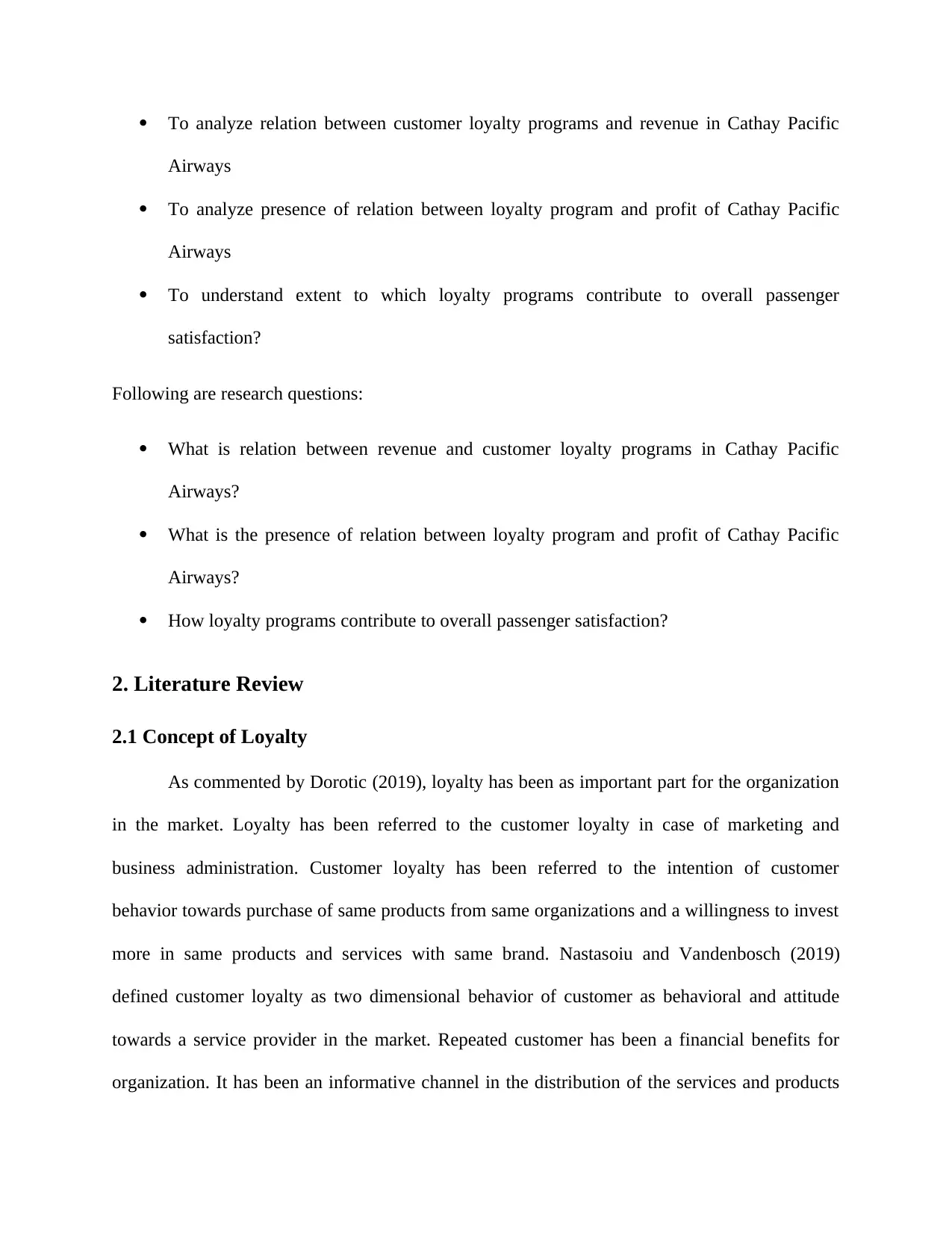
To analyze relation between customer loyalty programs and revenue in Cathay Pacific
Airways
To analyze presence of relation between loyalty program and profit of Cathay Pacific
Airways
To understand extent to which loyalty programs contribute to overall passenger
satisfaction?
Following are research questions:
What is relation between revenue and customer loyalty programs in Cathay Pacific
Airways?
What is the presence of relation between loyalty program and profit of Cathay Pacific
Airways?
How loyalty programs contribute to overall passenger satisfaction?
2. Literature Review
2.1 Concept of Loyalty
As commented by Dorotic (2019), loyalty has been as important part for the organization
in the market. Loyalty has been referred to the customer loyalty in case of marketing and
business administration. Customer loyalty has been referred to the intention of customer
behavior towards purchase of same products from same organizations and a willingness to invest
more in same products and services with same brand. Nastasoiu and Vandenbosch (2019)
defined customer loyalty as two dimensional behavior of customer as behavioral and attitude
towards a service provider in the market. Repeated customer has been a financial benefits for
organization. It has been an informative channel in the distribution of the services and products
Airways
To analyze presence of relation between loyalty program and profit of Cathay Pacific
Airways
To understand extent to which loyalty programs contribute to overall passenger
satisfaction?
Following are research questions:
What is relation between revenue and customer loyalty programs in Cathay Pacific
Airways?
What is the presence of relation between loyalty program and profit of Cathay Pacific
Airways?
How loyalty programs contribute to overall passenger satisfaction?
2. Literature Review
2.1 Concept of Loyalty
As commented by Dorotic (2019), loyalty has been as important part for the organization
in the market. Loyalty has been referred to the customer loyalty in case of marketing and
business administration. Customer loyalty has been referred to the intention of customer
behavior towards purchase of same products from same organizations and a willingness to invest
more in same products and services with same brand. Nastasoiu and Vandenbosch (2019)
defined customer loyalty as two dimensional behavior of customer as behavioral and attitude
towards a service provider in the market. Repeated customer has been a financial benefits for
organization. It has been an informative channel in the distribution of the services and products
Secure Best Marks with AI Grader
Need help grading? Try our AI Grader for instant feedback on your assignments.
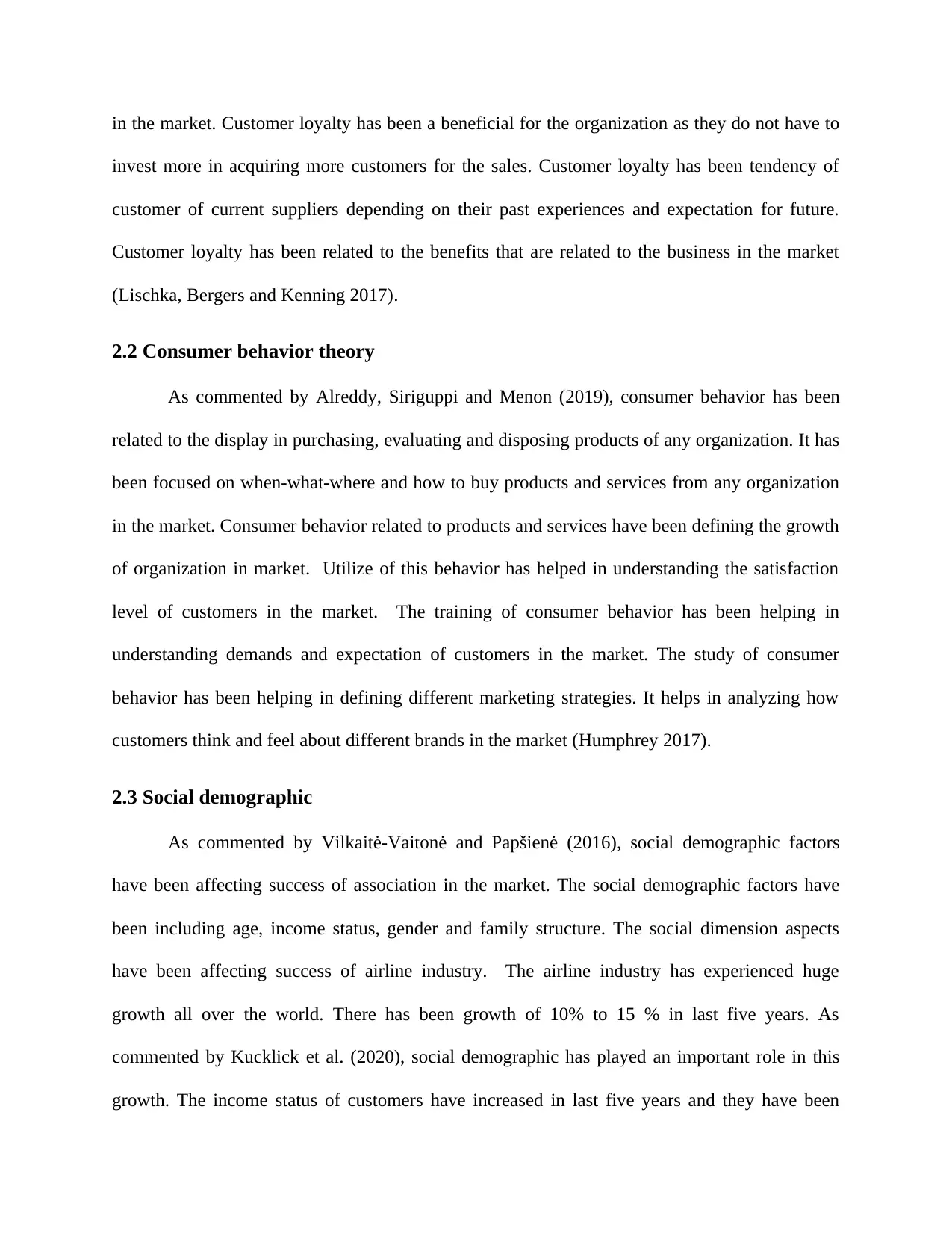
in the market. Customer loyalty has been a beneficial for the organization as they do not have to
invest more in acquiring more customers for the sales. Customer loyalty has been tendency of
customer of current suppliers depending on their past experiences and expectation for future.
Customer loyalty has been related to the benefits that are related to the business in the market
(Lischka, Bergers and Kenning 2017).
2.2 Consumer behavior theory
As commented by Alreddy, Siriguppi and Menon (2019), consumer behavior has been
related to the display in purchasing, evaluating and disposing products of any organization. It has
been focused on when-what-where and how to buy products and services from any organization
in the market. Consumer behavior related to products and services have been defining the growth
of organization in market. Utilize of this behavior has helped in understanding the satisfaction
level of customers in the market. The training of consumer behavior has been helping in
understanding demands and expectation of customers in the market. The study of consumer
behavior has been helping in defining different marketing strategies. It helps in analyzing how
customers think and feel about different brands in the market (Humphrey 2017).
2.3 Social demographic
As commented by Vilkaitė-Vaitonė and Papšienė (2016), social demographic factors
have been affecting success of association in the market. The social demographic factors have
been including age, income status, gender and family structure. The social dimension aspects
have been affecting success of airline industry. The airline industry has experienced huge
growth all over the world. There has been growth of 10% to 15 % in last five years. As
commented by Kucklick et al. (2020), social demographic has played an important role in this
growth. The income status of customers have increased in last five years and they have been
invest more in acquiring more customers for the sales. Customer loyalty has been tendency of
customer of current suppliers depending on their past experiences and expectation for future.
Customer loyalty has been related to the benefits that are related to the business in the market
(Lischka, Bergers and Kenning 2017).
2.2 Consumer behavior theory
As commented by Alreddy, Siriguppi and Menon (2019), consumer behavior has been
related to the display in purchasing, evaluating and disposing products of any organization. It has
been focused on when-what-where and how to buy products and services from any organization
in the market. Consumer behavior related to products and services have been defining the growth
of organization in market. Utilize of this behavior has helped in understanding the satisfaction
level of customers in the market. The training of consumer behavior has been helping in
understanding demands and expectation of customers in the market. The study of consumer
behavior has been helping in defining different marketing strategies. It helps in analyzing how
customers think and feel about different brands in the market (Humphrey 2017).
2.3 Social demographic
As commented by Vilkaitė-Vaitonė and Papšienė (2016), social demographic factors
have been affecting success of association in the market. The social demographic factors have
been including age, income status, gender and family structure. The social dimension aspects
have been affecting success of airline industry. The airline industry has experienced huge
growth all over the world. There has been growth of 10% to 15 % in last five years. As
commented by Kucklick et al. (2020), social demographic has played an important role in this
growth. The income status of customers have increased in last five years and they have been
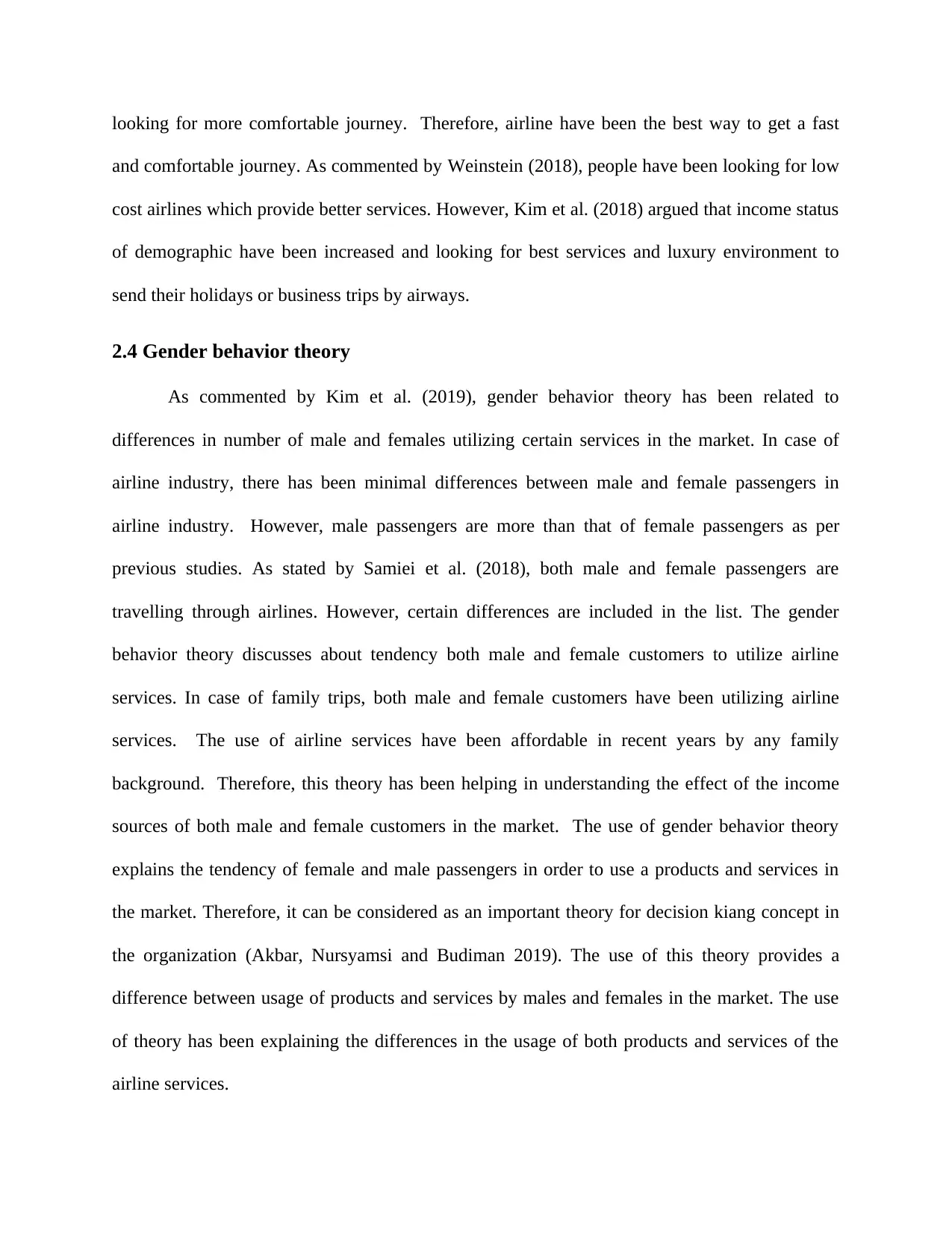
looking for more comfortable journey. Therefore, airline have been the best way to get a fast
and comfortable journey. As commented by Weinstein (2018), people have been looking for low
cost airlines which provide better services. However, Kim et al. (2018) argued that income status
of demographic have been increased and looking for best services and luxury environment to
send their holidays or business trips by airways.
2.4 Gender behavior theory
As commented by Kim et al. (2019), gender behavior theory has been related to
differences in number of male and females utilizing certain services in the market. In case of
airline industry, there has been minimal differences between male and female passengers in
airline industry. However, male passengers are more than that of female passengers as per
previous studies. As stated by Samiei et al. (2018), both male and female passengers are
travelling through airlines. However, certain differences are included in the list. The gender
behavior theory discusses about tendency both male and female customers to utilize airline
services. In case of family trips, both male and female customers have been utilizing airline
services. The use of airline services have been affordable in recent years by any family
background. Therefore, this theory has been helping in understanding the effect of the income
sources of both male and female customers in the market. The use of gender behavior theory
explains the tendency of female and male passengers in order to use a products and services in
the market. Therefore, it can be considered as an important theory for decision kiang concept in
the organization (Akbar, Nursyamsi and Budiman 2019). The use of this theory provides a
difference between usage of products and services by males and females in the market. The use
of theory has been explaining the differences in the usage of both products and services of the
airline services.
and comfortable journey. As commented by Weinstein (2018), people have been looking for low
cost airlines which provide better services. However, Kim et al. (2018) argued that income status
of demographic have been increased and looking for best services and luxury environment to
send their holidays or business trips by airways.
2.4 Gender behavior theory
As commented by Kim et al. (2019), gender behavior theory has been related to
differences in number of male and females utilizing certain services in the market. In case of
airline industry, there has been minimal differences between male and female passengers in
airline industry. However, male passengers are more than that of female passengers as per
previous studies. As stated by Samiei et al. (2018), both male and female passengers are
travelling through airlines. However, certain differences are included in the list. The gender
behavior theory discusses about tendency both male and female customers to utilize airline
services. In case of family trips, both male and female customers have been utilizing airline
services. The use of airline services have been affordable in recent years by any family
background. Therefore, this theory has been helping in understanding the effect of the income
sources of both male and female customers in the market. The use of gender behavior theory
explains the tendency of female and male passengers in order to use a products and services in
the market. Therefore, it can be considered as an important theory for decision kiang concept in
the organization (Akbar, Nursyamsi and Budiman 2019). The use of this theory provides a
difference between usage of products and services by males and females in the market. The use
of theory has been explaining the differences in the usage of both products and services of the
airline services.
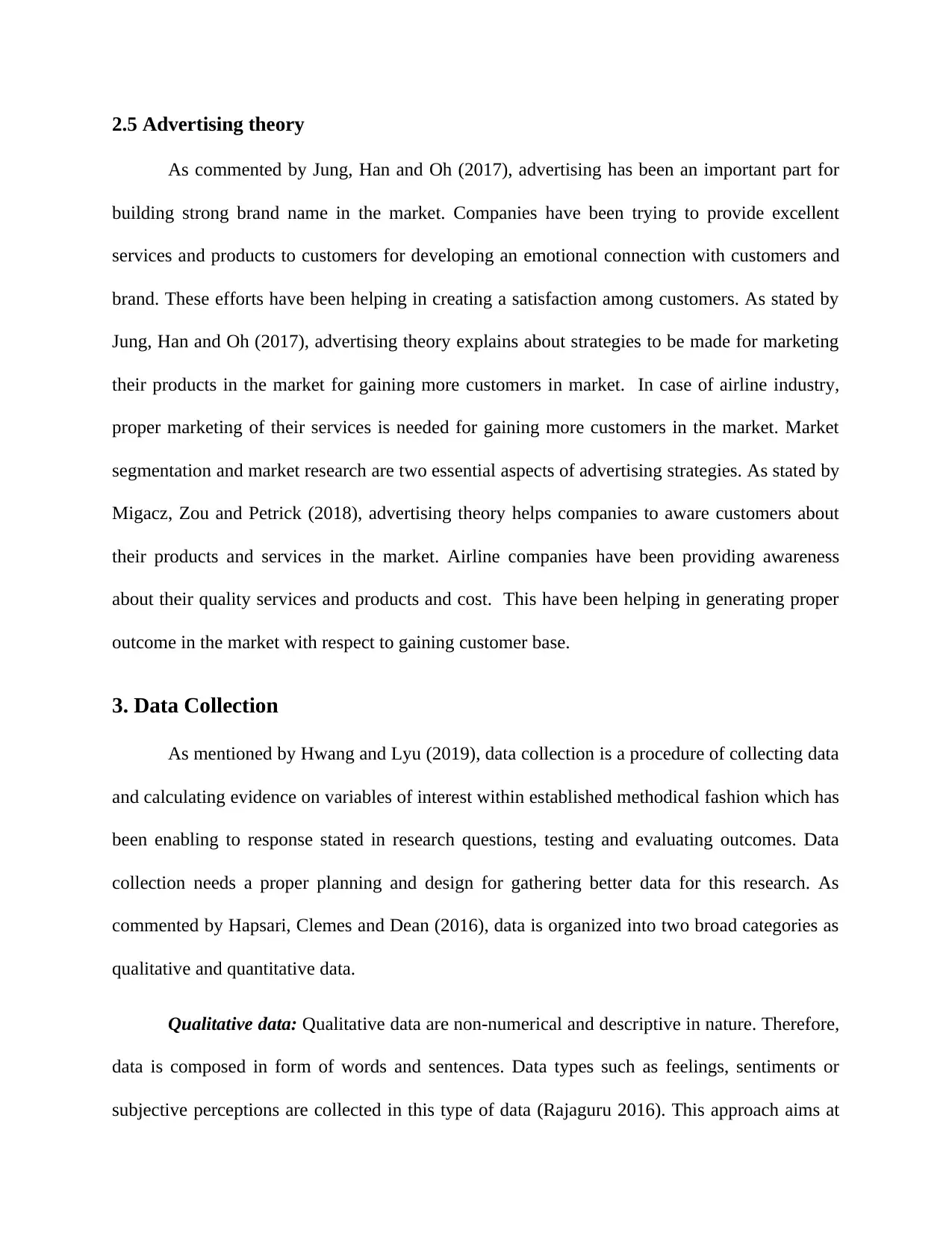
2.5 Advertising theory
As commented by Jung, Han and Oh (2017), advertising has been an important part for
building strong brand name in the market. Companies have been trying to provide excellent
services and products to customers for developing an emotional connection with customers and
brand. These efforts have been helping in creating a satisfaction among customers. As stated by
Jung, Han and Oh (2017), advertising theory explains about strategies to be made for marketing
their products in the market for gaining more customers in market. In case of airline industry,
proper marketing of their services is needed for gaining more customers in the market. Market
segmentation and market research are two essential aspects of advertising strategies. As stated by
Migacz, Zou and Petrick (2018), advertising theory helps companies to aware customers about
their products and services in the market. Airline companies have been providing awareness
about their quality services and products and cost. This have been helping in generating proper
outcome in the market with respect to gaining customer base.
3. Data Collection
As mentioned by Hwang and Lyu (2019), data collection is a procedure of collecting data
and calculating evidence on variables of interest within established methodical fashion which has
been enabling to response stated in research questions, testing and evaluating outcomes. Data
collection needs a proper planning and design for gathering better data for this research. As
commented by Hapsari, Clemes and Dean (2016), data is organized into two broad categories as
qualitative and quantitative data.
Qualitative data: Qualitative data are non-numerical and descriptive in nature. Therefore,
data is composed in form of words and sentences. Data types such as feelings, sentiments or
subjective perceptions are collected in this type of data (Rajaguru 2016). This approach aims at
As commented by Jung, Han and Oh (2017), advertising has been an important part for
building strong brand name in the market. Companies have been trying to provide excellent
services and products to customers for developing an emotional connection with customers and
brand. These efforts have been helping in creating a satisfaction among customers. As stated by
Jung, Han and Oh (2017), advertising theory explains about strategies to be made for marketing
their products in the market for gaining more customers in market. In case of airline industry,
proper marketing of their services is needed for gaining more customers in the market. Market
segmentation and market research are two essential aspects of advertising strategies. As stated by
Migacz, Zou and Petrick (2018), advertising theory helps companies to aware customers about
their products and services in the market. Airline companies have been providing awareness
about their quality services and products and cost. This have been helping in generating proper
outcome in the market with respect to gaining customer base.
3. Data Collection
As mentioned by Hwang and Lyu (2019), data collection is a procedure of collecting data
and calculating evidence on variables of interest within established methodical fashion which has
been enabling to response stated in research questions, testing and evaluating outcomes. Data
collection needs a proper planning and design for gathering better data for this research. As
commented by Hapsari, Clemes and Dean (2016), data is organized into two broad categories as
qualitative and quantitative data.
Qualitative data: Qualitative data are non-numerical and descriptive in nature. Therefore,
data is composed in form of words and sentences. Data types such as feelings, sentiments or
subjective perceptions are collected in this type of data (Rajaguru 2016). This approach aims at
Paraphrase This Document
Need a fresh take? Get an instant paraphrase of this document with our AI Paraphraser
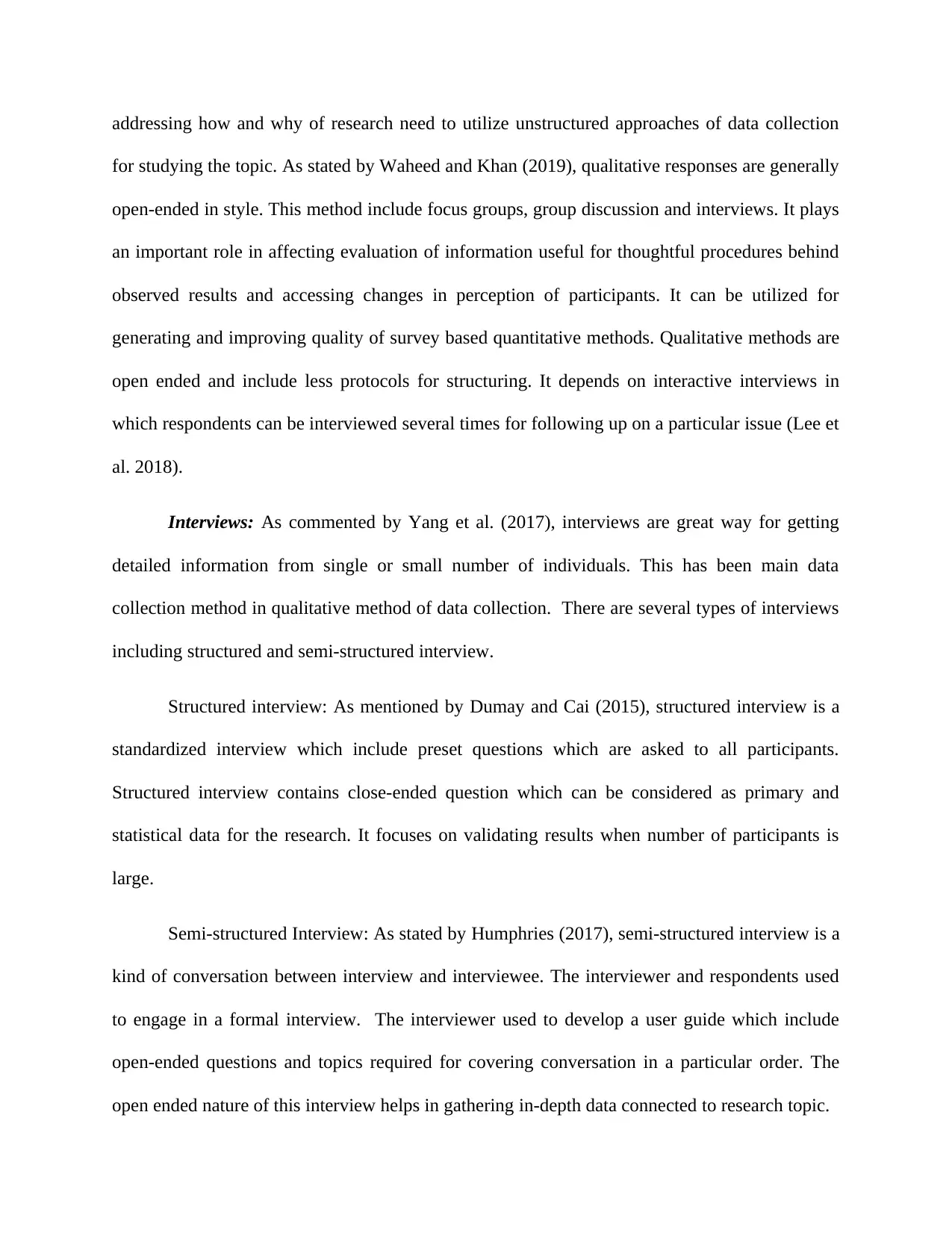
addressing how and why of research need to utilize unstructured approaches of data collection
for studying the topic. As stated by Waheed and Khan (2019), qualitative responses are generally
open-ended in style. This method include focus groups, group discussion and interviews. It plays
an important role in affecting evaluation of information useful for thoughtful procedures behind
observed results and accessing changes in perception of participants. It can be utilized for
generating and improving quality of survey based quantitative methods. Qualitative methods are
open ended and include less protocols for structuring. It depends on interactive interviews in
which respondents can be interviewed several times for following up on a particular issue (Lee et
al. 2018).
Interviews: As commented by Yang et al. (2017), interviews are great way for getting
detailed information from single or small number of individuals. This has been main data
collection method in qualitative method of data collection. There are several types of interviews
including structured and semi-structured interview.
Structured interview: As mentioned by Dumay and Cai (2015), structured interview is a
standardized interview which include preset questions which are asked to all participants.
Structured interview contains close-ended question which can be considered as primary and
statistical data for the research. It focuses on validating results when number of participants is
large.
Semi-structured Interview: As stated by Humphries (2017), semi-structured interview is a
kind of conversation between interview and interviewee. The interviewer and respondents used
to engage in a formal interview. The interviewer used to develop a user guide which include
open-ended questions and topics required for covering conversation in a particular order. The
open ended nature of this interview helps in gathering in-depth data connected to research topic.
for studying the topic. As stated by Waheed and Khan (2019), qualitative responses are generally
open-ended in style. This method include focus groups, group discussion and interviews. It plays
an important role in affecting evaluation of information useful for thoughtful procedures behind
observed results and accessing changes in perception of participants. It can be utilized for
generating and improving quality of survey based quantitative methods. Qualitative methods are
open ended and include less protocols for structuring. It depends on interactive interviews in
which respondents can be interviewed several times for following up on a particular issue (Lee et
al. 2018).
Interviews: As commented by Yang et al. (2017), interviews are great way for getting
detailed information from single or small number of individuals. This has been main data
collection method in qualitative method of data collection. There are several types of interviews
including structured and semi-structured interview.
Structured interview: As mentioned by Dumay and Cai (2015), structured interview is a
standardized interview which include preset questions which are asked to all participants.
Structured interview contains close-ended question which can be considered as primary and
statistical data for the research. It focuses on validating results when number of participants is
large.
Semi-structured Interview: As stated by Humphries (2017), semi-structured interview is a
kind of conversation between interview and interviewee. The interviewer and respondents used
to engage in a formal interview. The interviewer used to develop a user guide which include
open-ended questions and topics required for covering conversation in a particular order. The
open ended nature of this interview helps in gathering in-depth data connected to research topic.
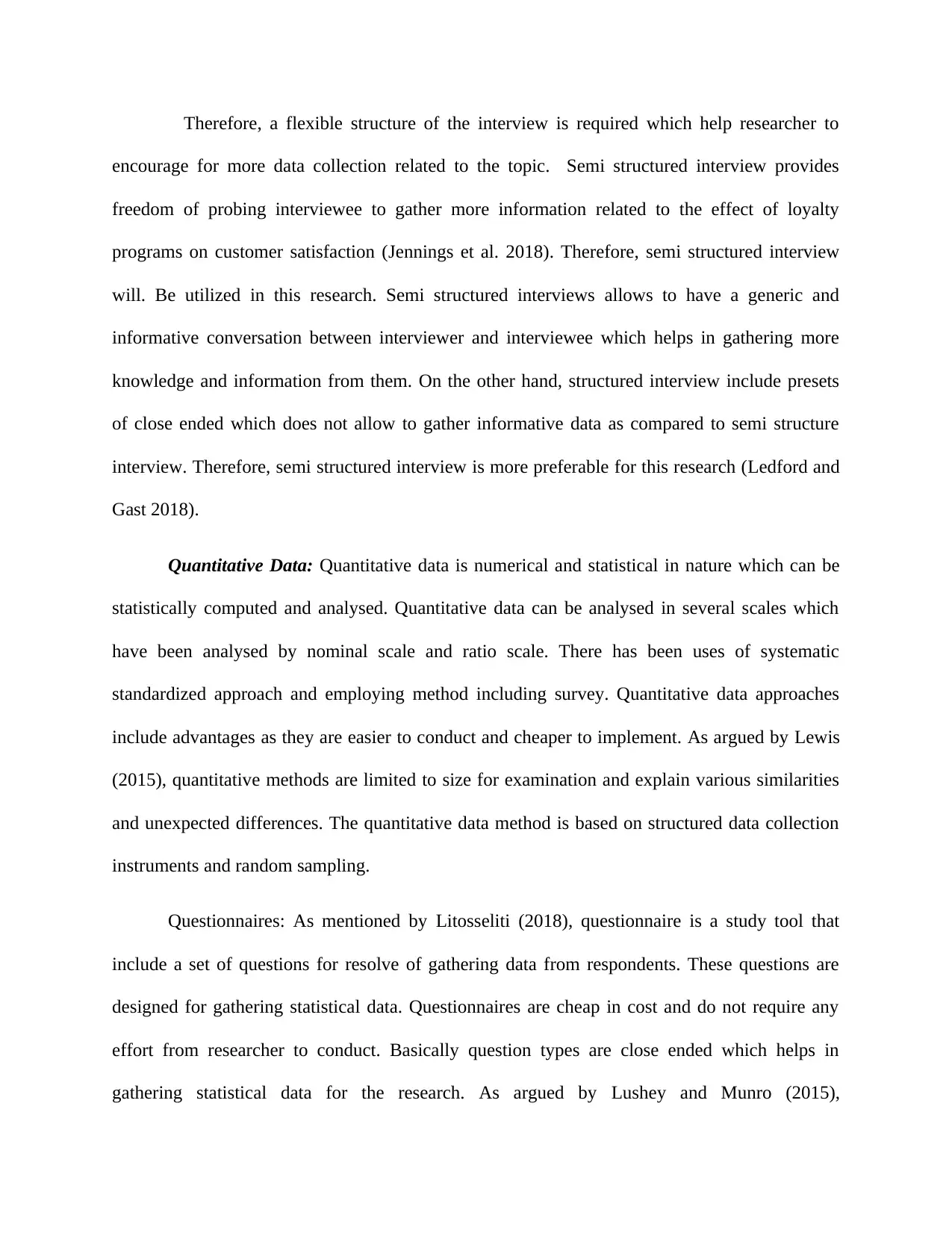
Therefore, a flexible structure of the interview is required which help researcher to
encourage for more data collection related to the topic. Semi structured interview provides
freedom of probing interviewee to gather more information related to the effect of loyalty
programs on customer satisfaction (Jennings et al. 2018). Therefore, semi structured interview
will. Be utilized in this research. Semi structured interviews allows to have a generic and
informative conversation between interviewer and interviewee which helps in gathering more
knowledge and information from them. On the other hand, structured interview include presets
of close ended which does not allow to gather informative data as compared to semi structure
interview. Therefore, semi structured interview is more preferable for this research (Ledford and
Gast 2018).
Quantitative Data: Quantitative data is numerical and statistical in nature which can be
statistically computed and analysed. Quantitative data can be analysed in several scales which
have been analysed by nominal scale and ratio scale. There has been uses of systematic
standardized approach and employing method including survey. Quantitative data approaches
include advantages as they are easier to conduct and cheaper to implement. As argued by Lewis
(2015), quantitative methods are limited to size for examination and explain various similarities
and unexpected differences. The quantitative data method is based on structured data collection
instruments and random sampling.
Questionnaires: As mentioned by Litosseliti (2018), questionnaire is a study tool that
include a set of questions for resolve of gathering data from respondents. These questions are
designed for gathering statistical data. Questionnaires are cheap in cost and do not require any
effort from researcher to conduct. Basically question types are close ended which helps in
gathering statistical data for the research. As argued by Lushey and Munro (2015),
encourage for more data collection related to the topic. Semi structured interview provides
freedom of probing interviewee to gather more information related to the effect of loyalty
programs on customer satisfaction (Jennings et al. 2018). Therefore, semi structured interview
will. Be utilized in this research. Semi structured interviews allows to have a generic and
informative conversation between interviewer and interviewee which helps in gathering more
knowledge and information from them. On the other hand, structured interview include presets
of close ended which does not allow to gather informative data as compared to semi structure
interview. Therefore, semi structured interview is more preferable for this research (Ledford and
Gast 2018).
Quantitative Data: Quantitative data is numerical and statistical in nature which can be
statistically computed and analysed. Quantitative data can be analysed in several scales which
have been analysed by nominal scale and ratio scale. There has been uses of systematic
standardized approach and employing method including survey. Quantitative data approaches
include advantages as they are easier to conduct and cheaper to implement. As argued by Lewis
(2015), quantitative methods are limited to size for examination and explain various similarities
and unexpected differences. The quantitative data method is based on structured data collection
instruments and random sampling.
Questionnaires: As mentioned by Litosseliti (2018), questionnaire is a study tool that
include a set of questions for resolve of gathering data from respondents. These questions are
designed for gathering statistical data. Questionnaires are cheap in cost and do not require any
effort from researcher to conduct. Basically question types are close ended which helps in
gathering statistical data for the research. As argued by Lushey and Munro (2015),
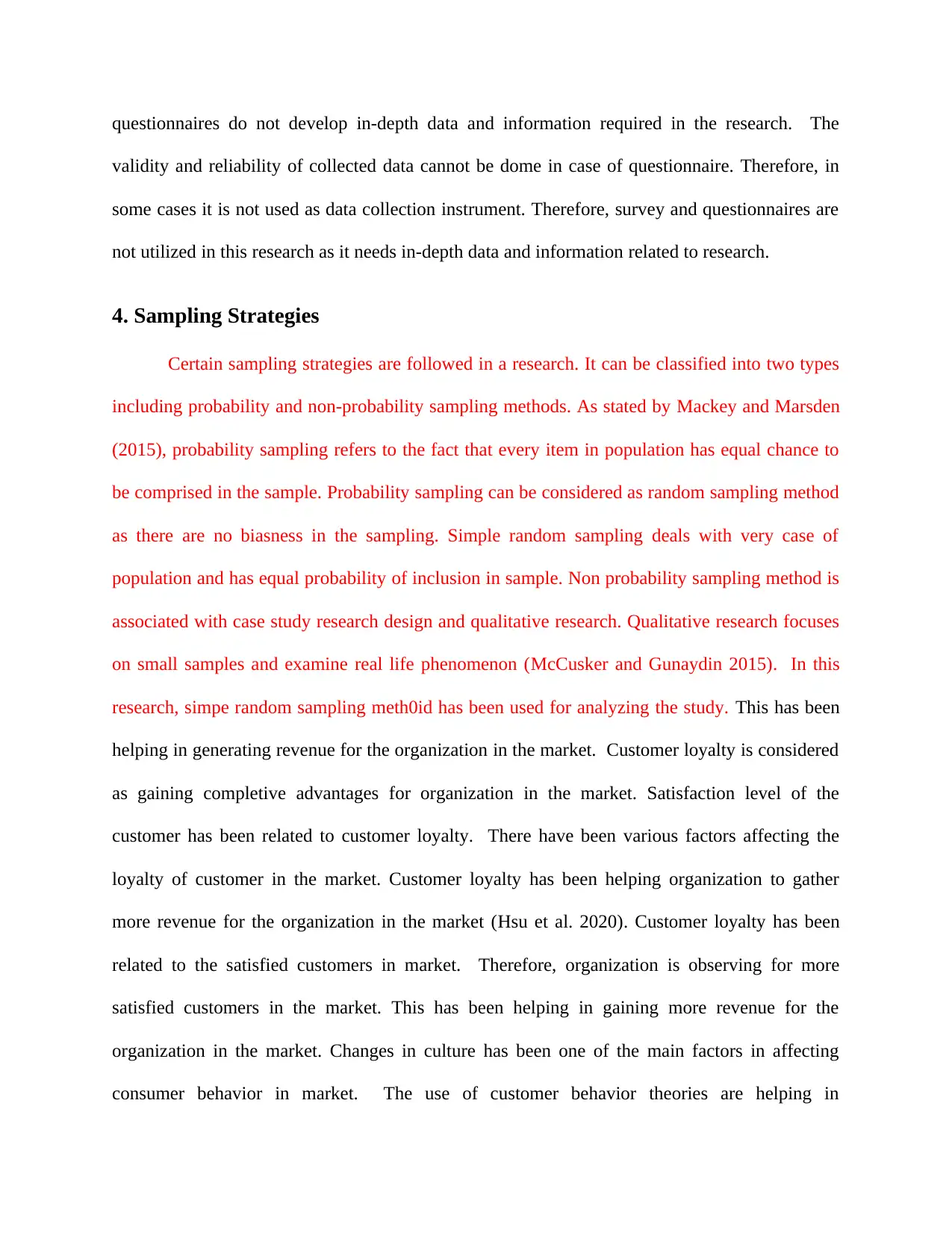
questionnaires do not develop in-depth data and information required in the research. The
validity and reliability of collected data cannot be dome in case of questionnaire. Therefore, in
some cases it is not used as data collection instrument. Therefore, survey and questionnaires are
not utilized in this research as it needs in-depth data and information related to research.
4. Sampling Strategies
Certain sampling strategies are followed in a research. It can be classified into two types
including probability and non-probability sampling methods. As stated by Mackey and Marsden
(2015), probability sampling refers to the fact that every item in population has equal chance to
be comprised in the sample. Probability sampling can be considered as random sampling method
as there are no biasness in the sampling. Simple random sampling deals with very case of
population and has equal probability of inclusion in sample. Non probability sampling method is
associated with case study research design and qualitative research. Qualitative research focuses
on small samples and examine real life phenomenon (McCusker and Gunaydin 2015). In this
research, simpe random sampling meth0id has been used for analyzing the study. This has been
helping in generating revenue for the organization in the market. Customer loyalty is considered
as gaining completive advantages for organization in the market. Satisfaction level of the
customer has been related to customer loyalty. There have been various factors affecting the
loyalty of customer in the market. Customer loyalty has been helping organization to gather
more revenue for the organization in the market (Hsu et al. 2020). Customer loyalty has been
related to the satisfied customers in market. Therefore, organization is observing for more
satisfied customers in the market. This has been helping in gaining more revenue for the
organization in the market. Changes in culture has been one of the main factors in affecting
consumer behavior in market. The use of customer behavior theories are helping in
validity and reliability of collected data cannot be dome in case of questionnaire. Therefore, in
some cases it is not used as data collection instrument. Therefore, survey and questionnaires are
not utilized in this research as it needs in-depth data and information related to research.
4. Sampling Strategies
Certain sampling strategies are followed in a research. It can be classified into two types
including probability and non-probability sampling methods. As stated by Mackey and Marsden
(2015), probability sampling refers to the fact that every item in population has equal chance to
be comprised in the sample. Probability sampling can be considered as random sampling method
as there are no biasness in the sampling. Simple random sampling deals with very case of
population and has equal probability of inclusion in sample. Non probability sampling method is
associated with case study research design and qualitative research. Qualitative research focuses
on small samples and examine real life phenomenon (McCusker and Gunaydin 2015). In this
research, simpe random sampling meth0id has been used for analyzing the study. This has been
helping in generating revenue for the organization in the market. Customer loyalty is considered
as gaining completive advantages for organization in the market. Satisfaction level of the
customer has been related to customer loyalty. There have been various factors affecting the
loyalty of customer in the market. Customer loyalty has been helping organization to gather
more revenue for the organization in the market (Hsu et al. 2020). Customer loyalty has been
related to the satisfied customers in market. Therefore, organization is observing for more
satisfied customers in the market. This has been helping in gaining more revenue for the
organization in the market. Changes in culture has been one of the main factors in affecting
consumer behavior in market. The use of customer behavior theories are helping in
Secure Best Marks with AI Grader
Need help grading? Try our AI Grader for instant feedback on your assignments.
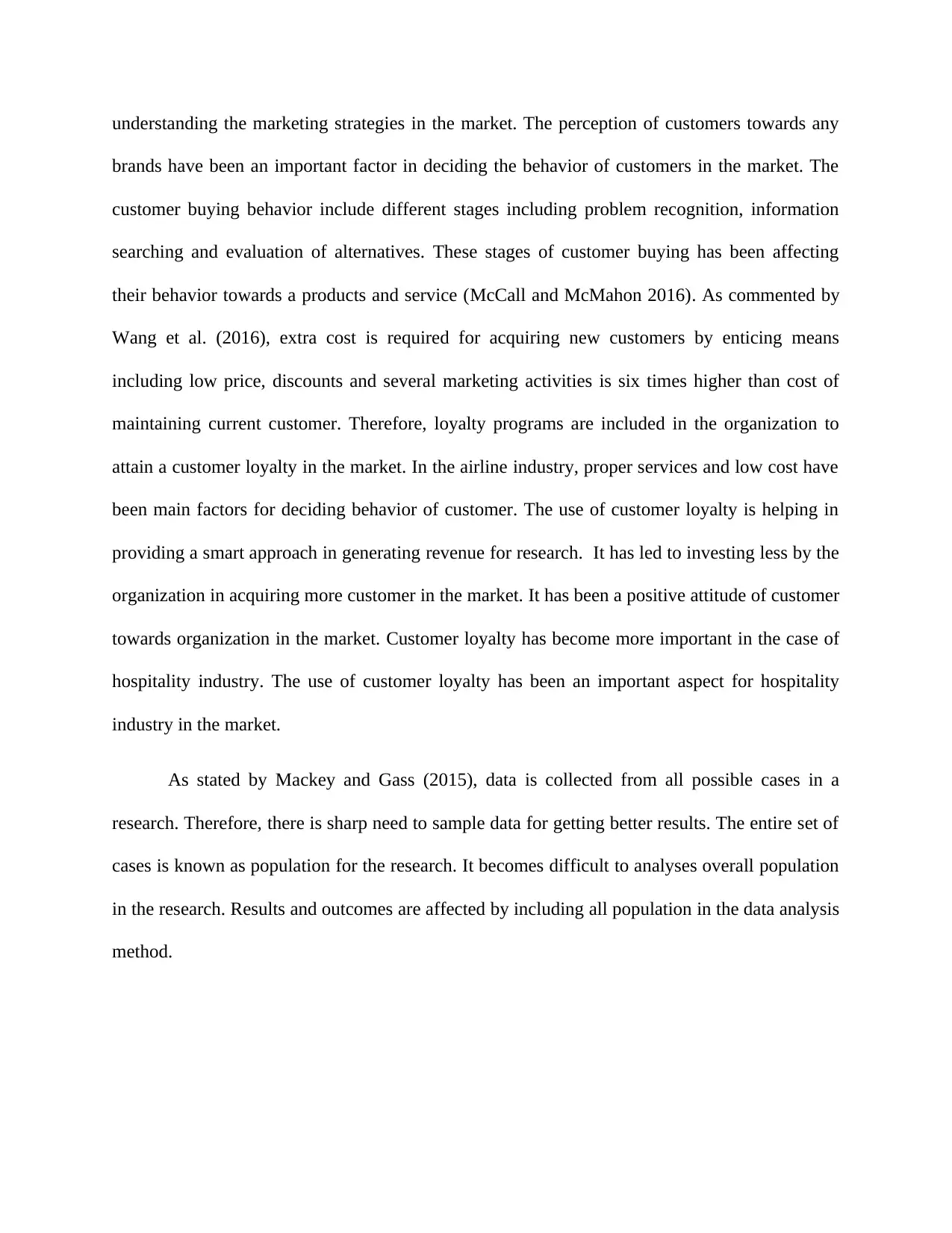
understanding the marketing strategies in the market. The perception of customers towards any
brands have been an important factor in deciding the behavior of customers in the market. The
customer buying behavior include different stages including problem recognition, information
searching and evaluation of alternatives. These stages of customer buying has been affecting
their behavior towards a products and service (McCall and McMahon 2016). As commented by
Wang et al. (2016), extra cost is required for acquiring new customers by enticing means
including low price, discounts and several marketing activities is six times higher than cost of
maintaining current customer. Therefore, loyalty programs are included in the organization to
attain a customer loyalty in the market. In the airline industry, proper services and low cost have
been main factors for deciding behavior of customer. The use of customer loyalty is helping in
providing a smart approach in generating revenue for research. It has led to investing less by the
organization in acquiring more customer in the market. It has been a positive attitude of customer
towards organization in the market. Customer loyalty has become more important in the case of
hospitality industry. The use of customer loyalty has been an important aspect for hospitality
industry in the market.
As stated by Mackey and Gass (2015), data is collected from all possible cases in a
research. Therefore, there is sharp need to sample data for getting better results. The entire set of
cases is known as population for the research. It becomes difficult to analyses overall population
in the research. Results and outcomes are affected by including all population in the data analysis
method.
brands have been an important factor in deciding the behavior of customers in the market. The
customer buying behavior include different stages including problem recognition, information
searching and evaluation of alternatives. These stages of customer buying has been affecting
their behavior towards a products and service (McCall and McMahon 2016). As commented by
Wang et al. (2016), extra cost is required for acquiring new customers by enticing means
including low price, discounts and several marketing activities is six times higher than cost of
maintaining current customer. Therefore, loyalty programs are included in the organization to
attain a customer loyalty in the market. In the airline industry, proper services and low cost have
been main factors for deciding behavior of customer. The use of customer loyalty is helping in
providing a smart approach in generating revenue for research. It has led to investing less by the
organization in acquiring more customer in the market. It has been a positive attitude of customer
towards organization in the market. Customer loyalty has become more important in the case of
hospitality industry. The use of customer loyalty has been an important aspect for hospitality
industry in the market.
As stated by Mackey and Gass (2015), data is collected from all possible cases in a
research. Therefore, there is sharp need to sample data for getting better results. The entire set of
cases is known as population for the research. It becomes difficult to analyses overall population
in the research. Results and outcomes are affected by including all population in the data analysis
method.
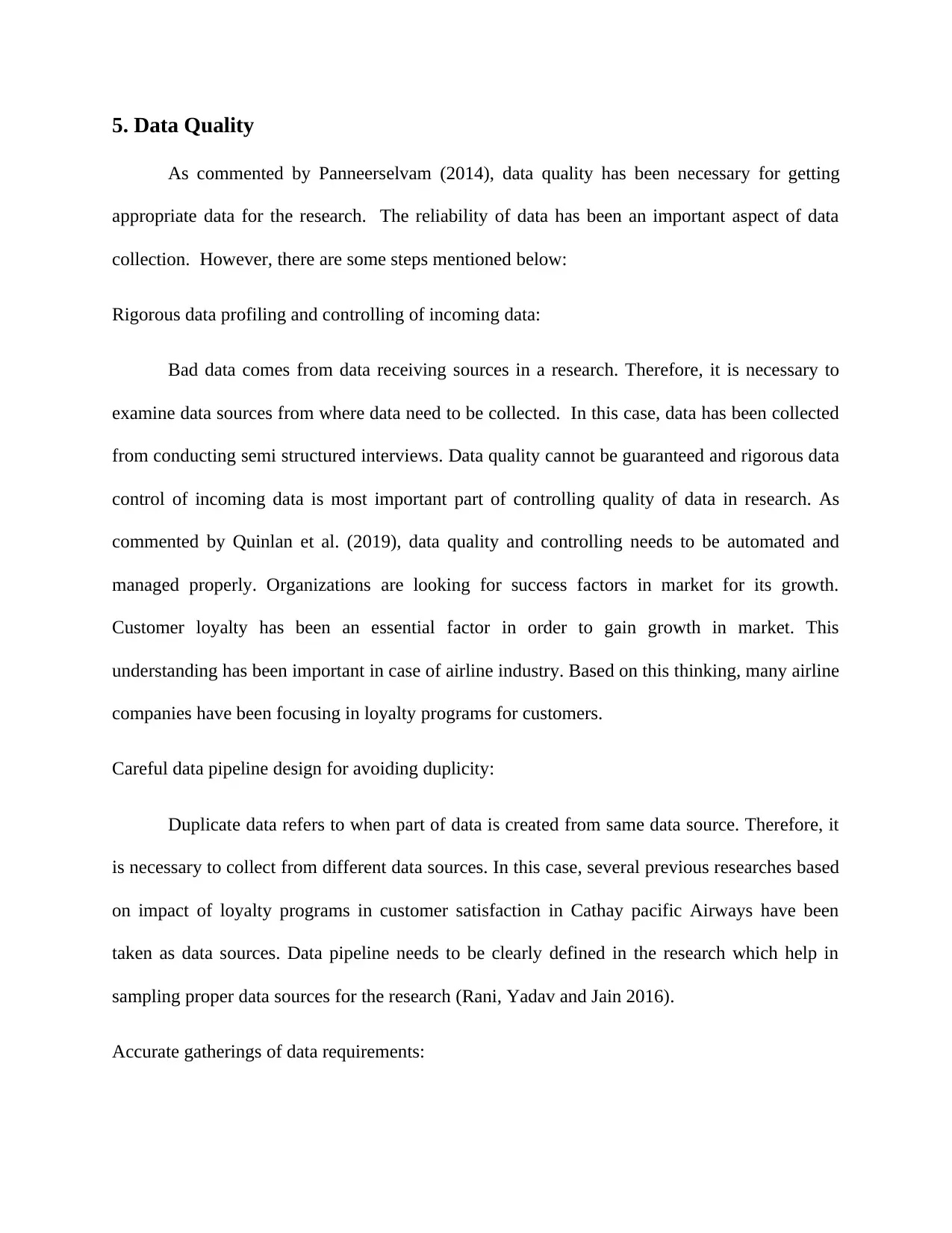
5. Data Quality
As commented by Panneerselvam (2014), data quality has been necessary for getting
appropriate data for the research. The reliability of data has been an important aspect of data
collection. However, there are some steps mentioned below:
Rigorous data profiling and controlling of incoming data:
Bad data comes from data receiving sources in a research. Therefore, it is necessary to
examine data sources from where data need to be collected. In this case, data has been collected
from conducting semi structured interviews. Data quality cannot be guaranteed and rigorous data
control of incoming data is most important part of controlling quality of data in research. As
commented by Quinlan et al. (2019), data quality and controlling needs to be automated and
managed properly. Organizations are looking for success factors in market for its growth.
Customer loyalty has been an essential factor in order to gain growth in market. This
understanding has been important in case of airline industry. Based on this thinking, many airline
companies have been focusing in loyalty programs for customers.
Careful data pipeline design for avoiding duplicity:
Duplicate data refers to when part of data is created from same data source. Therefore, it
is necessary to collect from different data sources. In this case, several previous researches based
on impact of loyalty programs in customer satisfaction in Cathay pacific Airways have been
taken as data sources. Data pipeline needs to be clearly defined in the research which help in
sampling proper data sources for the research (Rani, Yadav and Jain 2016).
Accurate gatherings of data requirements:
As commented by Panneerselvam (2014), data quality has been necessary for getting
appropriate data for the research. The reliability of data has been an important aspect of data
collection. However, there are some steps mentioned below:
Rigorous data profiling and controlling of incoming data:
Bad data comes from data receiving sources in a research. Therefore, it is necessary to
examine data sources from where data need to be collected. In this case, data has been collected
from conducting semi structured interviews. Data quality cannot be guaranteed and rigorous data
control of incoming data is most important part of controlling quality of data in research. As
commented by Quinlan et al. (2019), data quality and controlling needs to be automated and
managed properly. Organizations are looking for success factors in market for its growth.
Customer loyalty has been an essential factor in order to gain growth in market. This
understanding has been important in case of airline industry. Based on this thinking, many airline
companies have been focusing in loyalty programs for customers.
Careful data pipeline design for avoiding duplicity:
Duplicate data refers to when part of data is created from same data source. Therefore, it
is necessary to collect from different data sources. In this case, several previous researches based
on impact of loyalty programs in customer satisfaction in Cathay pacific Airways have been
taken as data sources. Data pipeline needs to be clearly defined in the research which help in
sampling proper data sources for the research (Rani, Yadav and Jain 2016).
Accurate gatherings of data requirements:
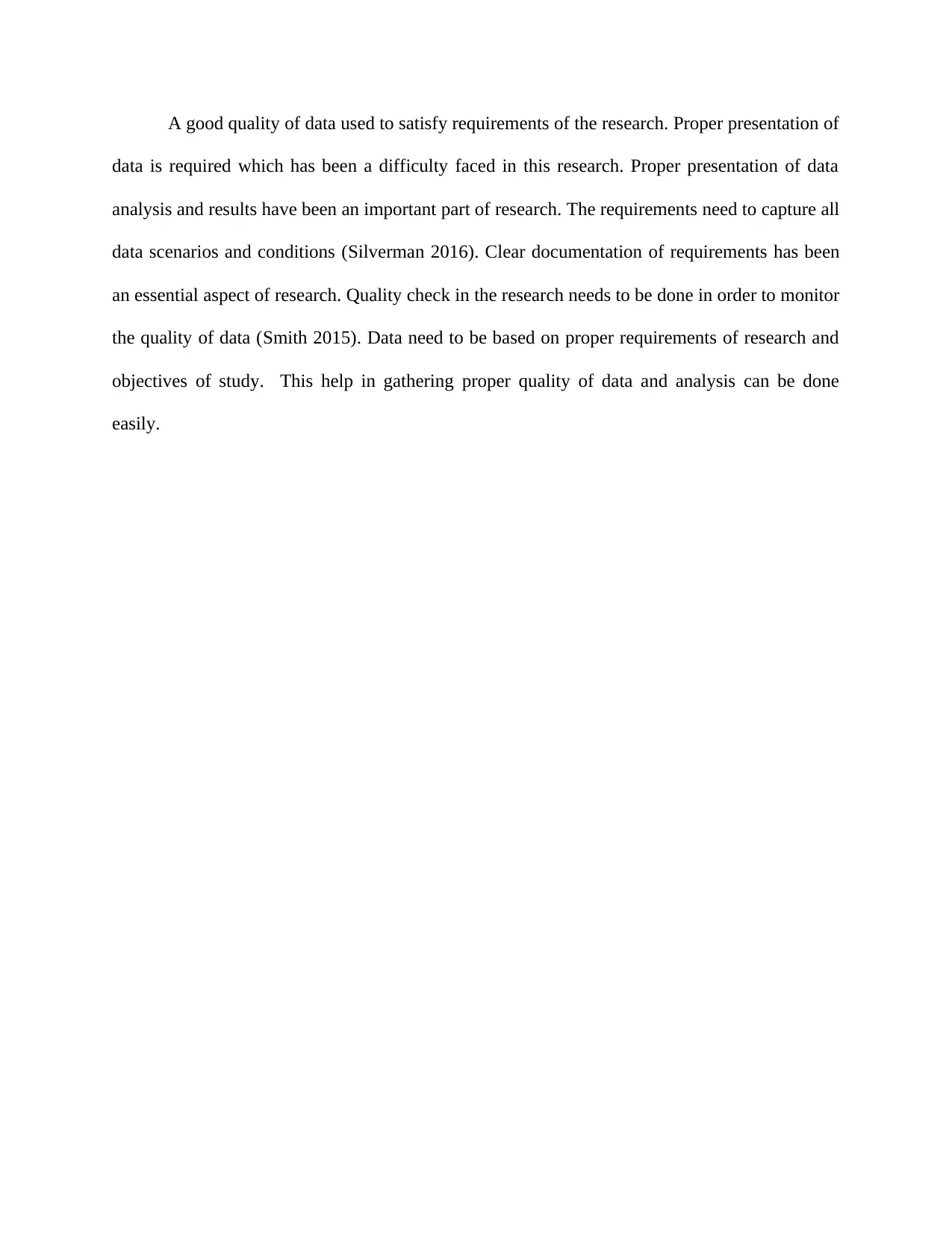
A good quality of data used to satisfy requirements of the research. Proper presentation of
data is required which has been a difficulty faced in this research. Proper presentation of data
analysis and results have been an important part of research. The requirements need to capture all
data scenarios and conditions (Silverman 2016). Clear documentation of requirements has been
an essential aspect of research. Quality check in the research needs to be done in order to monitor
the quality of data (Smith 2015). Data need to be based on proper requirements of research and
objectives of study. This help in gathering proper quality of data and analysis can be done
easily.
data is required which has been a difficulty faced in this research. Proper presentation of data
analysis and results have been an important part of research. The requirements need to capture all
data scenarios and conditions (Silverman 2016). Clear documentation of requirements has been
an essential aspect of research. Quality check in the research needs to be done in order to monitor
the quality of data (Smith 2015). Data need to be based on proper requirements of research and
objectives of study. This help in gathering proper quality of data and analysis can be done
easily.
Paraphrase This Document
Need a fresh take? Get an instant paraphrase of this document with our AI Paraphraser
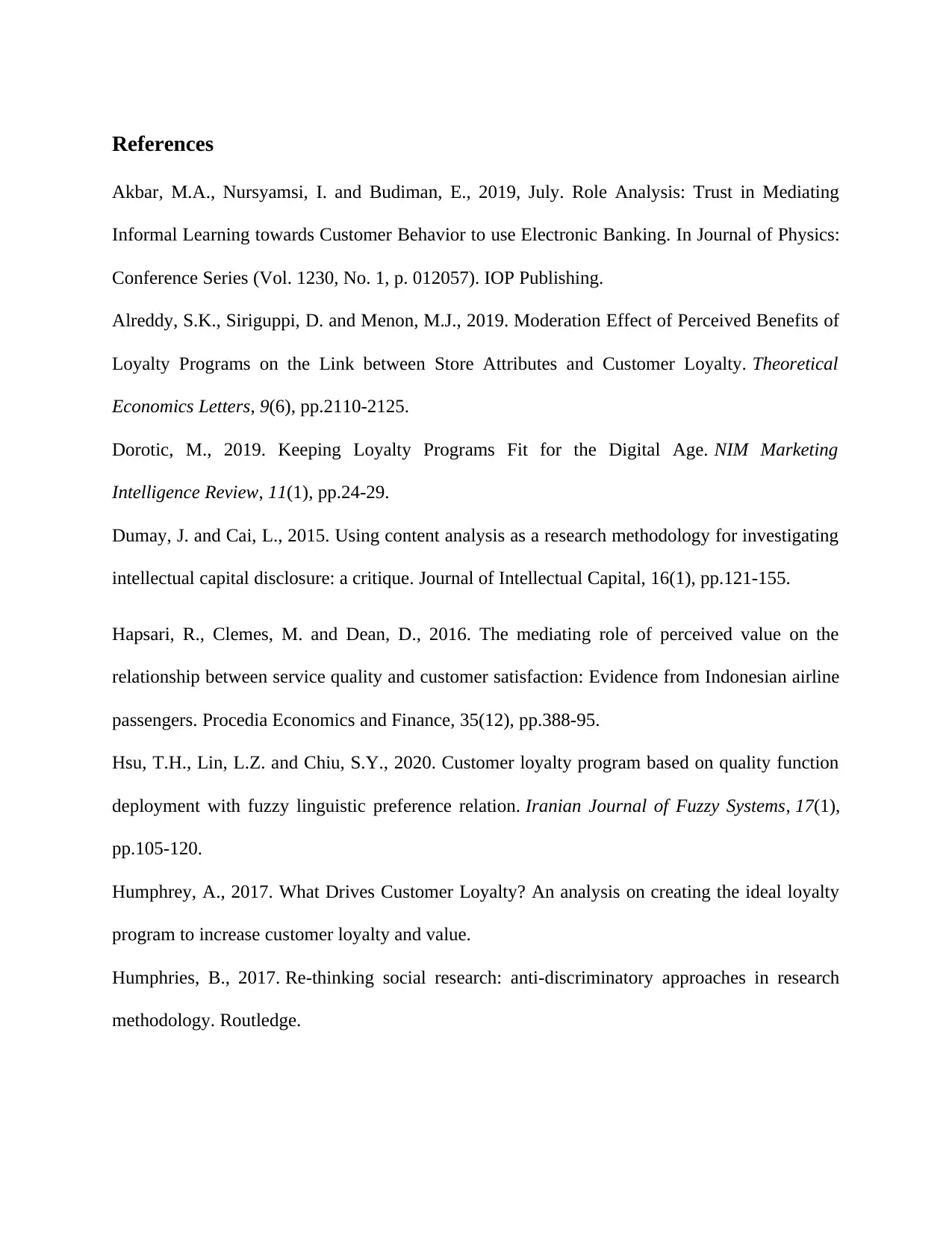
References
Akbar, M.A., Nursyamsi, I. and Budiman, E., 2019, July. Role Analysis: Trust in Mediating
Informal Learning towards Customer Behavior to use Electronic Banking. In Journal of Physics:
Conference Series (Vol. 1230, No. 1, p. 012057). IOP Publishing.
Alreddy, S.K., Siriguppi, D. and Menon, M.J., 2019. Moderation Effect of Perceived Benefits of
Loyalty Programs on the Link between Store Attributes and Customer Loyalty. Theoretical
Economics Letters, 9(6), pp.2110-2125.
Dorotic, M., 2019. Keeping Loyalty Programs Fit for the Digital Age. NIM Marketing
Intelligence Review, 11(1), pp.24-29.
Dumay, J. and Cai, L., 2015. Using content analysis as a research methodology for investigating
intellectual capital disclosure: a critique. Journal of Intellectual Capital, 16(1), pp.121-155.
Hapsari, R., Clemes, M. and Dean, D., 2016. The mediating role of perceived value on the
relationship between service quality and customer satisfaction: Evidence from Indonesian airline
passengers. Procedia Economics and Finance, 35(12), pp.388-95.
Hsu, T.H., Lin, L.Z. and Chiu, S.Y., 2020. Customer loyalty program based on quality function
deployment with fuzzy linguistic preference relation. Iranian Journal of Fuzzy Systems, 17(1),
pp.105-120.
Humphrey, A., 2017. What Drives Customer Loyalty? An analysis on creating the ideal loyalty
program to increase customer loyalty and value.
Humphries, B., 2017. Re-thinking social research: anti-discriminatory approaches in research
methodology. Routledge.
Akbar, M.A., Nursyamsi, I. and Budiman, E., 2019, July. Role Analysis: Trust in Mediating
Informal Learning towards Customer Behavior to use Electronic Banking. In Journal of Physics:
Conference Series (Vol. 1230, No. 1, p. 012057). IOP Publishing.
Alreddy, S.K., Siriguppi, D. and Menon, M.J., 2019. Moderation Effect of Perceived Benefits of
Loyalty Programs on the Link between Store Attributes and Customer Loyalty. Theoretical
Economics Letters, 9(6), pp.2110-2125.
Dorotic, M., 2019. Keeping Loyalty Programs Fit for the Digital Age. NIM Marketing
Intelligence Review, 11(1), pp.24-29.
Dumay, J. and Cai, L., 2015. Using content analysis as a research methodology for investigating
intellectual capital disclosure: a critique. Journal of Intellectual Capital, 16(1), pp.121-155.
Hapsari, R., Clemes, M. and Dean, D., 2016. The mediating role of perceived value on the
relationship between service quality and customer satisfaction: Evidence from Indonesian airline
passengers. Procedia Economics and Finance, 35(12), pp.388-95.
Hsu, T.H., Lin, L.Z. and Chiu, S.Y., 2020. Customer loyalty program based on quality function
deployment with fuzzy linguistic preference relation. Iranian Journal of Fuzzy Systems, 17(1),
pp.105-120.
Humphrey, A., 2017. What Drives Customer Loyalty? An analysis on creating the ideal loyalty
program to increase customer loyalty and value.
Humphries, B., 2017. Re-thinking social research: anti-discriminatory approaches in research
methodology. Routledge.
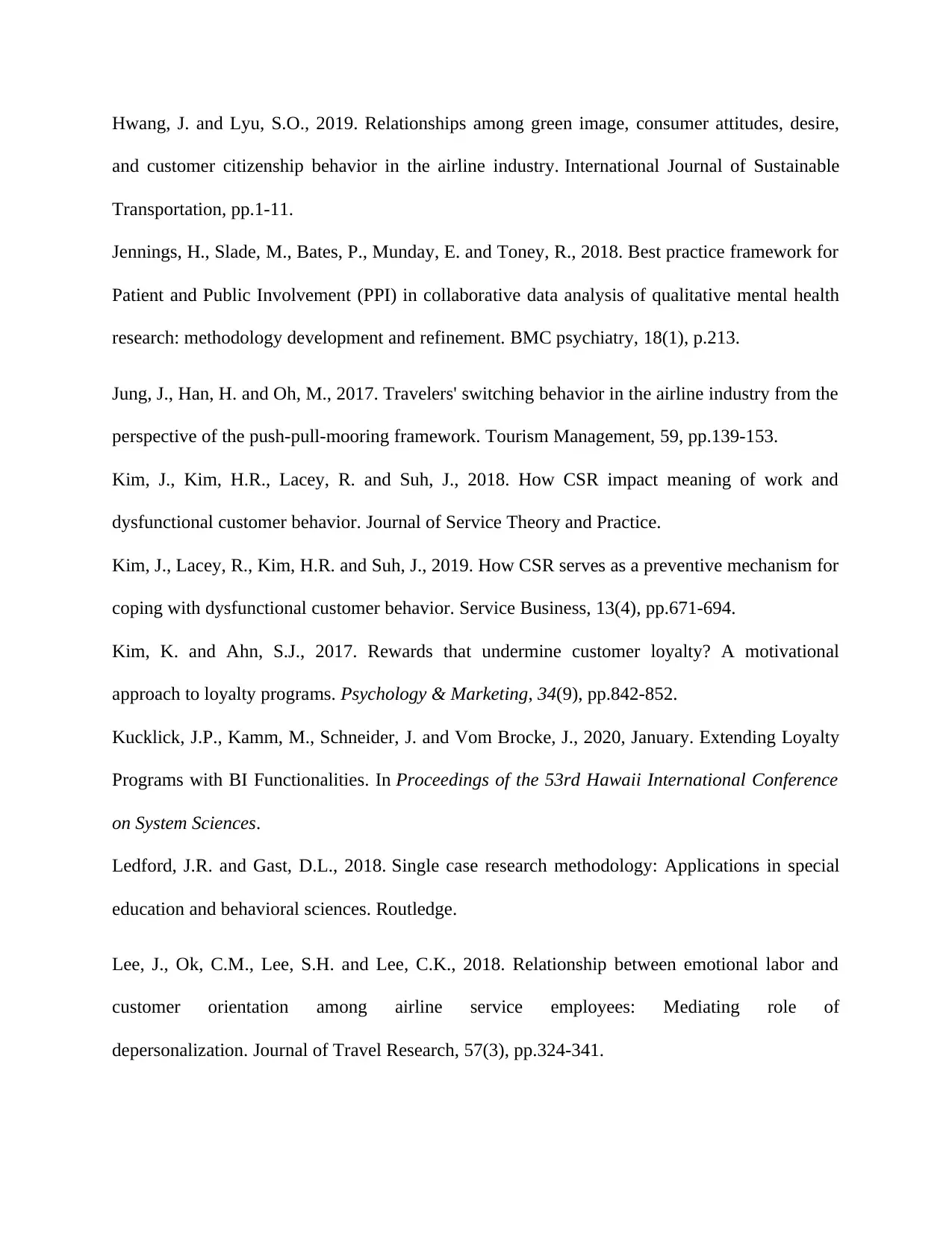
Hwang, J. and Lyu, S.O., 2019. Relationships among green image, consumer attitudes, desire,
and customer citizenship behavior in the airline industry. International Journal of Sustainable
Transportation, pp.1-11.
Jennings, H., Slade, M., Bates, P., Munday, E. and Toney, R., 2018. Best practice framework for
Patient and Public Involvement (PPI) in collaborative data analysis of qualitative mental health
research: methodology development and refinement. BMC psychiatry, 18(1), p.213.
Jung, J., Han, H. and Oh, M., 2017. Travelers' switching behavior in the airline industry from the
perspective of the push-pull-mooring framework. Tourism Management, 59, pp.139-153.
Kim, J., Kim, H.R., Lacey, R. and Suh, J., 2018. How CSR impact meaning of work and
dysfunctional customer behavior. Journal of Service Theory and Practice.
Kim, J., Lacey, R., Kim, H.R. and Suh, J., 2019. How CSR serves as a preventive mechanism for
coping with dysfunctional customer behavior. Service Business, 13(4), pp.671-694.
Kim, K. and Ahn, S.J., 2017. Rewards that undermine customer loyalty? A motivational
approach to loyalty programs. Psychology & Marketing, 34(9), pp.842-852.
Kucklick, J.P., Kamm, M., Schneider, J. and Vom Brocke, J., 2020, January. Extending Loyalty
Programs with BI Functionalities. In Proceedings of the 53rd Hawaii International Conference
on System Sciences.
Ledford, J.R. and Gast, D.L., 2018. Single case research methodology: Applications in special
education and behavioral sciences. Routledge.
Lee, J., Ok, C.M., Lee, S.H. and Lee, C.K., 2018. Relationship between emotional labor and
customer orientation among airline service employees: Mediating role of
depersonalization. Journal of Travel Research, 57(3), pp.324-341.
and customer citizenship behavior in the airline industry. International Journal of Sustainable
Transportation, pp.1-11.
Jennings, H., Slade, M., Bates, P., Munday, E. and Toney, R., 2018. Best practice framework for
Patient and Public Involvement (PPI) in collaborative data analysis of qualitative mental health
research: methodology development and refinement. BMC psychiatry, 18(1), p.213.
Jung, J., Han, H. and Oh, M., 2017. Travelers' switching behavior in the airline industry from the
perspective of the push-pull-mooring framework. Tourism Management, 59, pp.139-153.
Kim, J., Kim, H.R., Lacey, R. and Suh, J., 2018. How CSR impact meaning of work and
dysfunctional customer behavior. Journal of Service Theory and Practice.
Kim, J., Lacey, R., Kim, H.R. and Suh, J., 2019. How CSR serves as a preventive mechanism for
coping with dysfunctional customer behavior. Service Business, 13(4), pp.671-694.
Kim, K. and Ahn, S.J., 2017. Rewards that undermine customer loyalty? A motivational
approach to loyalty programs. Psychology & Marketing, 34(9), pp.842-852.
Kucklick, J.P., Kamm, M., Schneider, J. and Vom Brocke, J., 2020, January. Extending Loyalty
Programs with BI Functionalities. In Proceedings of the 53rd Hawaii International Conference
on System Sciences.
Ledford, J.R. and Gast, D.L., 2018. Single case research methodology: Applications in special
education and behavioral sciences. Routledge.
Lee, J., Ok, C.M., Lee, S.H. and Lee, C.K., 2018. Relationship between emotional labor and
customer orientation among airline service employees: Mediating role of
depersonalization. Journal of Travel Research, 57(3), pp.324-341.
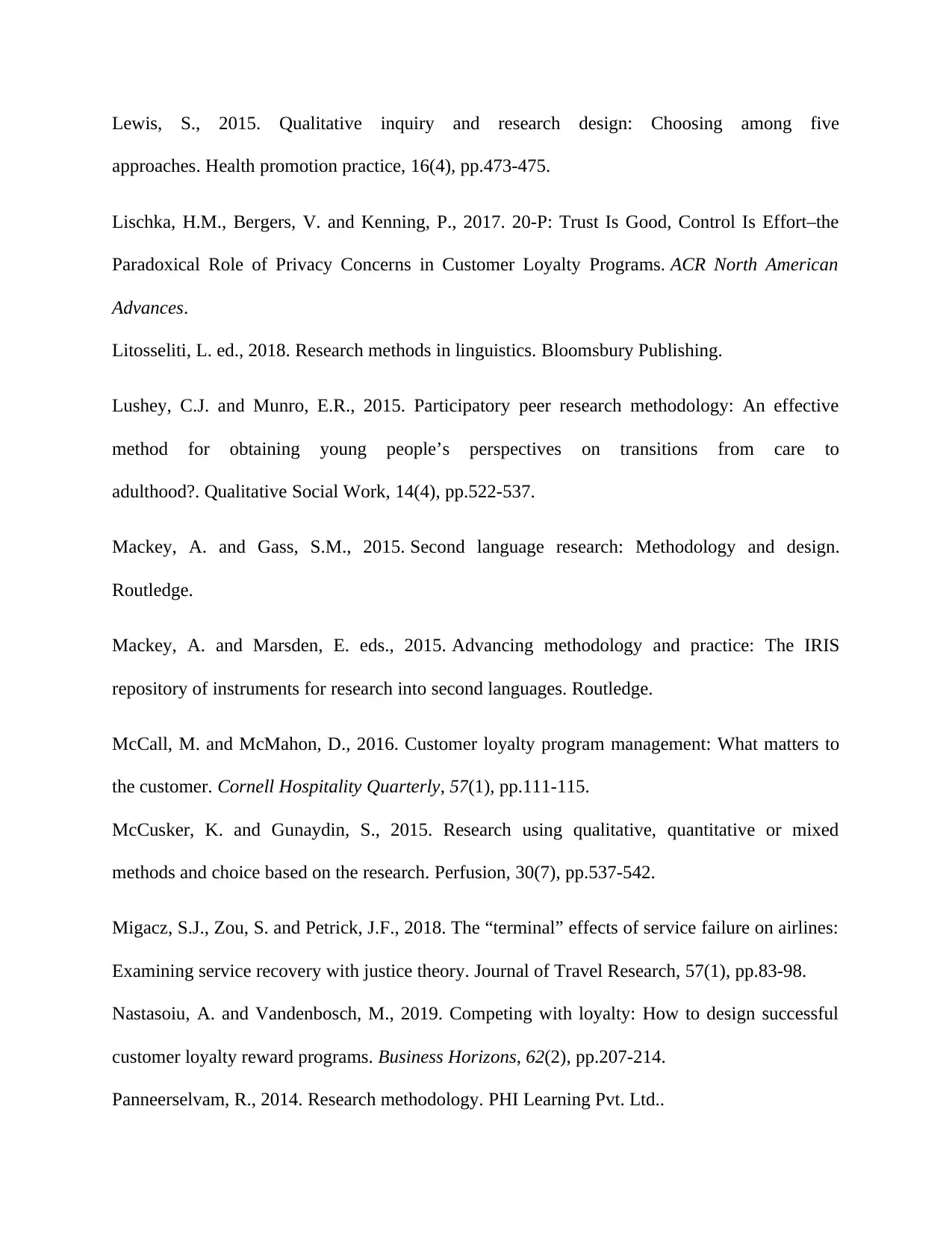
Lewis, S., 2015. Qualitative inquiry and research design: Choosing among five
approaches. Health promotion practice, 16(4), pp.473-475.
Lischka, H.M., Bergers, V. and Kenning, P., 2017. 20-P: Trust Is Good, Control Is Effort–the
Paradoxical Role of Privacy Concerns in Customer Loyalty Programs. ACR North American
Advances.
Litosseliti, L. ed., 2018. Research methods in linguistics. Bloomsbury Publishing.
Lushey, C.J. and Munro, E.R., 2015. Participatory peer research methodology: An effective
method for obtaining young people’s perspectives on transitions from care to
adulthood?. Qualitative Social Work, 14(4), pp.522-537.
Mackey, A. and Gass, S.M., 2015. Second language research: Methodology and design.
Routledge.
Mackey, A. and Marsden, E. eds., 2015. Advancing methodology and practice: The IRIS
repository of instruments for research into second languages. Routledge.
McCall, M. and McMahon, D., 2016. Customer loyalty program management: What matters to
the customer. Cornell Hospitality Quarterly, 57(1), pp.111-115.
McCusker, K. and Gunaydin, S., 2015. Research using qualitative, quantitative or mixed
methods and choice based on the research. Perfusion, 30(7), pp.537-542.
Migacz, S.J., Zou, S. and Petrick, J.F., 2018. The “terminal” effects of service failure on airlines:
Examining service recovery with justice theory. Journal of Travel Research, 57(1), pp.83-98.
Nastasoiu, A. and Vandenbosch, M., 2019. Competing with loyalty: How to design successful
customer loyalty reward programs. Business Horizons, 62(2), pp.207-214.
Panneerselvam, R., 2014. Research methodology. PHI Learning Pvt. Ltd..
approaches. Health promotion practice, 16(4), pp.473-475.
Lischka, H.M., Bergers, V. and Kenning, P., 2017. 20-P: Trust Is Good, Control Is Effort–the
Paradoxical Role of Privacy Concerns in Customer Loyalty Programs. ACR North American
Advances.
Litosseliti, L. ed., 2018. Research methods in linguistics. Bloomsbury Publishing.
Lushey, C.J. and Munro, E.R., 2015. Participatory peer research methodology: An effective
method for obtaining young people’s perspectives on transitions from care to
adulthood?. Qualitative Social Work, 14(4), pp.522-537.
Mackey, A. and Gass, S.M., 2015. Second language research: Methodology and design.
Routledge.
Mackey, A. and Marsden, E. eds., 2015. Advancing methodology and practice: The IRIS
repository of instruments for research into second languages. Routledge.
McCall, M. and McMahon, D., 2016. Customer loyalty program management: What matters to
the customer. Cornell Hospitality Quarterly, 57(1), pp.111-115.
McCusker, K. and Gunaydin, S., 2015. Research using qualitative, quantitative or mixed
methods and choice based on the research. Perfusion, 30(7), pp.537-542.
Migacz, S.J., Zou, S. and Petrick, J.F., 2018. The “terminal” effects of service failure on airlines:
Examining service recovery with justice theory. Journal of Travel Research, 57(1), pp.83-98.
Nastasoiu, A. and Vandenbosch, M., 2019. Competing with loyalty: How to design successful
customer loyalty reward programs. Business Horizons, 62(2), pp.207-214.
Panneerselvam, R., 2014. Research methodology. PHI Learning Pvt. Ltd..
1 out of 16
Related Documents
Your All-in-One AI-Powered Toolkit for Academic Success.
+13062052269
info@desklib.com
Available 24*7 on WhatsApp / Email
![[object Object]](/_next/static/media/star-bottom.7253800d.svg)
Unlock your academic potential
© 2024 | Zucol Services PVT LTD | All rights reserved.




